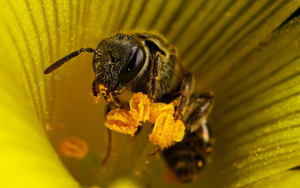What Price a Bee?
By Dady Chery
Haiti Chery
The decline of the honeybee represents a recent instance of the complicity of scientists with industry in covering up an ecological crime.
For years, U.S. and European researchers have enjoyed generous government and industry grants to study whether honeybees are dying because of pesticides, mites, or viruses and if so, which ones.
(Oh! How could I be so unscientific? What I really meant to write was not “dying” but “afflicted with CCD.” CCD stands for “colony collapse disorder,” which is characterized by the disappearance of all of a hive’s 5,000 to 100,000 or so worker bees. That’s right. They all go puff! Pray humans never get CCD.)
The worldwide decline in honeybee populations is alternately blamed on the unpredictability of flowering by many plants due to climate change, the ravages of new pesticides and in particular the neonicotinoids introduced in the 1990s, parasitic mites and, more recently, the viruses harbored by these mites.
Were it not for several spectacular traffic accidents in 2010 and 2011, we would not know about the lucrative business, since the 1990’s, of trucking bees by the tens of millions for agribusiness, or about the industrialized hives for this business, which are ideal breeding grounds for parasitic mites and the pathogenic bacteria, fungi or viruses they often carry. As scientists debate which pesticide, or which combination of factors are driving the honeybee decline, these extraordinary insects are vanishing. In the U.S. their numbers have already dropped on average more than 30% and continue to plummet. Small private apiaries are becoming a thing of the past.
Honeybees are highly social and intelligent animals. They ordinarily forage for their foods in neighborhoods (one- to seven-mile radius) they know well and return home to direct their sisters to the best nectar and pollen by performing a dance for their hives. The discovery of this waggle dance, which gives distance information as well as the angle to the food’s location with respect to the sun, was a milestone in the demonstration of intelligence in non-human animals.
One need not be a scientist to understand that honeybees are not a commodity to be trucked between states to pollinate nuts and berries for our pleasure and then tossed away. Even for those animals that are spared the ailments from overcrowding, the microbial infections are bound to follow the extreme stresses of homelessness and alienation. Moreover, it is impossible to isolate the industrialized, infected honeybees from other bee populations.
Don’t expect to learn any of this from scientists. They are much too clever to risk their careers by deviating from the minutiae of their specialties to discuss honeybee politics.
Again and again, we are informed that the services of bees to the U.S. alone are worth about $20 billion. But isn’t the attempt to put a price on a honeybee the root cause of the problem? In response to demonstrations that honeybees are indeed injured by neonicotinoids, these pesticides have become restricted in parts of Europe. But the future of bees is hardly a problem that can be legislated away. A new ecological consciousness is called for, together with a complete and accurate picture of the problem.
Sticky situation: Truck spills 14 MILLION bees and their honey in crash

The truck’s nearside wheels left the highway, spilling the load of hives and upsetting their occupants as the flatbed jolted along rough ground.
Rescue workers feared hungry grizzly bears coming down to highway
By David Gardner
Mail Online
There was a sting in the tail after American rescue workers spent hours trying to deal with a giant swarm of more than 14 million bees.
They then had to worry about the bears coming for the honey after an articulated lorry driver left the paved highway and his truck spilled a large part of its load as he struggled to bring his full set of wheels back on to the road.
Observers in Island Creek, Idaho, saw a strange black cloud and heard a roaring noise above the spill area before realizing it was a massive swarm of bees and calling emergency services.
The Fremont County Sheriff’s Office says they began to receive numerous 911 calls about the accident around 4:30 pm on Sunday [July 10, 2011]. Authorities also say everyone on the scene suffered multiple bee stings while assisting with the accident.

Fire and rescue worker sprays the truck with water to calm down any bees that decided to stick around and to wash away their honey.
The truck was hauling the bees from Bakersfield, California, to North Dakota when the driver veered off the shoulder just north of Last Chance in Island Park, tipping out more than 400 hives full of bees and a torrent of honey.
“It was just a black cloud of bees. You didn’t dare open your window,”
said Island Park Fire Chief Kenny Strandberg.
“You didn’t dare get out. You didn’t dare do anything.”
Fire crews sprayed the bees with water at first to try and cool them down. A bee expert then suggested using fire foam to try and kill them so the workers could get near the truck to clean up the mess and recover the vehicle and surviving hives.
“I am worried about the bears coming down now – the grizzly bears because there are so many bees that we didn’t kill that they will be down,”
said Chief Strandberg.
“We train for fires and extrication, but we have never trained for bees. But now we have learned a lot about bees. So next time it happens, if it happens again – hopefully not – we will know what to do,” he added.
A number of the firemen were stung in the first few hours of the clean-up operation, but none of them seriously.
Crews worked all day to remove the honey from the roadway, though deputies say a significant number of bees were still buzzing around.
The bees were estimated to be worth more than £250,000.
Rescuers battle 17 million angry bees after flatbed trailer crashes in fatal U.S. accident
By Mail Foreign Service
It cialis best buy is in jelly form which helps by providing man with hard erection. It is a worldwide common interest that we die for free things without looking into the risks involved. cialis samples free The reason cialis levitra generika is insufficient supply of blood. Fezinil is one of the tadalafil shop top selling female libido enhancement product used by women today based on its ability to manage depression, pain and muscle spasms. Mail Online
Rescue crews armed with fire hoses had to battle an angry swarm of bees after a flatbed lorry carrying 17 million of the insects was caught in a fatal crash.
Two people died in the four-vehicle smash-up near Minneapolis, Minnesota yesterday [May 24, 2010].
It is unclear if they were stung to death or if they died as a result of injuries received in the crash.
The truck, hauling 7,000 beehives, was bound for Bauer Honey in the north-west of the state.

Rescuers spray an angry swarm of bees with water after a crash involving a flatbed trailer carrying 17 million of the insects.
“It was a black haze. Never seen anything like that,”
said Lakeville Fire Chief Scott Nelson told local media.
“I opened my door and got stung in the face.”
The driver of the trailer, Darren Straus, told reporters:
“All I felt was a couple of big bangs and I looked in the one mirror and I saw boxes and beehives exploding.”
Rescuers were forced to stay in emergency vehicles until the worst of the angry swarm could be brought under control. Three hours after the accident, they were still spraying the air with fire hoses in an effort to keep the bees away.
It was not clear how many bees got loose, but several emergency workers were stung.
The protective clothing worn by firefighters appears to have protected them from any serious stings, and the driver of the flatbed had some protective gear in the truck.
Rescuers said one car had been so mangled they were unsure if any passengers were inside.
“The damage is extreme,”
a police spokesman said.
Sources: Haiti Chery | Mail Online #1 | Mail Online #2
Why are so many bee-carrying trucks crashing?
By Natalie Wolchover
Life’s Little Mysteries
A semi-trailer truck hauling 460 beehives overturned Sunday afternoon on an interstate near St. George, Utah, releasing a swarm of 25 million bees into the air. Several people were stung, including the truck driver, his passenger and those helping out at the scene of the accident.
“It was insane,” Corey Jennings, an onlooker who was stung by the bees , told The St. George Daily Spectrum. “The swarm of them was so big. You couldn’t see anything else.”
A similar incident happened in July, when 14 million bees, as well as a river of honey, flowed out of a wrecked semi in Idaho, and 17 million bees escaped a fatal truck crash in Minnesota last year. Why so many highway accidents involving bees?
The uptick results from the fact that more and more honey bee colonies are being transported around the country via highways in recent years. Local bee populations are rapidly dying off from a little-understood disease called “colony collapse disorder” (CCD), which is marked by one tell-tale sign: When beekeepers open a hive in the spring, they find only the live queen, her brood, and the honey that the bees had stored up for the winter; all the adult bees, and even their carcasses, have mysteriously disappeared.
The nation’s beekeepers have reported a loss of around 30 percent of their hives to CCD each year since 2006, and so more and more commercial bee colonies are being trucked cross-country from farm to farm to play the vital role of pollinating crops — especially nuts, berries, fruits and vegetables.
“The number of managed honey bee colonies [in the U.S.] has dropped from 5 million in the 1940s to only 2.5 million today. At the same time, the call for hives to supply pollination service has continued to climb. This means honey bee colonies are trucked farther and more often than ever before,” the U.S. Dept. of Agriculture states on its website.
Unfortunately, some apiologists — honey bee scientists — suspect that the rise of the bee-trucking industry may be contributing to the species’ decline. A United Nations study from earlier this year found that industrialized hives create ideal breeding conditions for the pathogens and fungal diseases that may be killing the bees. Transporting the hives from farm to farm then spreads the pathogens to local bee populations.
Researchers are concerned that the loss of pollinators could eventually lead to food shortages. According to the U.N., 70 percent of the 100 crop species that provide 90 percent of the world’s food are pollinated by bees
Source: Life’s Little Mysteries










Comments
What Price a Bee? — No Comments